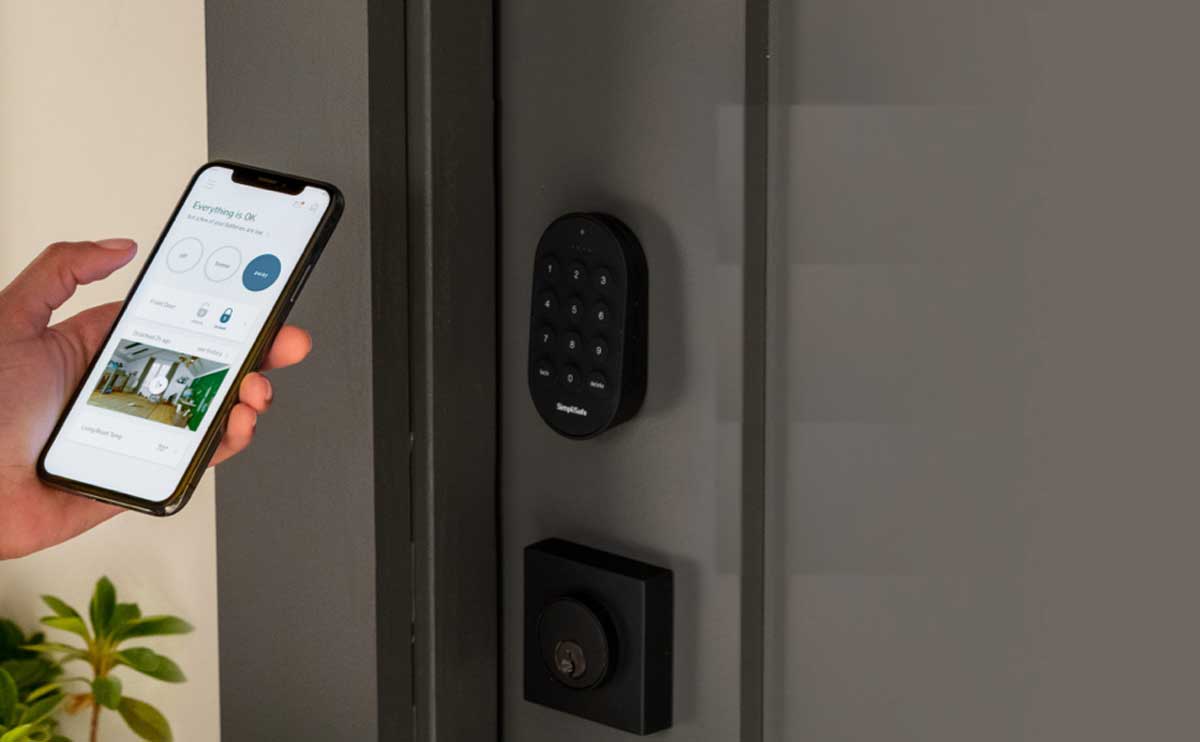Best Home Security Monitoring Companies Compared: Systems, Cameras, vs Self Monitoring, And More
When you purchase through links on our site, we may earn a commission. Here’s how it works.
 Did you know that the security company you buy your system from is most likely different from the company that monitors the system? That’s why it’s important to purchase a security system from a company with quality equipment and a responsive monitoring company.
Did you know that the security company you buy your system from is most likely different from the company that monitors the system? That’s why it’s important to purchase a security system from a company with quality equipment and a responsive monitoring company.
Article Overview
- Monitoring Station Features
- Most Reliable Home Security Providers
- How Are Authorities Notified When There’s An Alarm?
- Landline vs Broadband vs Cellular Monitoring
- Self vs Professional Monitoring
- Comparison Table
- Why Monitoring Matters
Features Of The Best Monitoring Stations
There are three major things we suggest you look into before buying your security system: the central monitoring station’s redundancy (how many stations it has in case one goes down temporarily), its average response time, and third-party independent monitoring capabilities.
1) Redundancy – How Many Central Monitoring Stations Are There?
Redundancy is the number of monitoring stations and how solid the infrastructure is. It’s vital that each monitoring company have at least 2 monitoring stations located in different U.S. regions (or at least states). While there should definitely be at least 2 monitoring stations, it doesn’t mean having more stations makes it better.
Why? Because monitoring stations can experience power outages and natural disasters, just like our homes. If a monitoring station loses power, the alarm calls need to be routed to a different station to ensure that help arrives at your door. Monitoring stations need to communicate efficiently with one another to get help quickly to those in need.
In our home security systems reviews, we take into account how many monitoring stations each security company has, as well as how reliable the monitoring stations are.
2) Response Time – How Quickly Are Authorities Dispatched?
Response time is an industry term used to state how quickly a monitoring station alerts your local emergency authorities when an alarm triggers. This is not the time it takes authorities to respond to a home alarm (that time can vary based on your location, how busy the authorities are, etc.). However, the faster the monitoring station’s response time, the sooner a homeowner is called to verify the situation and, in turn, police or firefighters are notified to act on the emergency.
3) Third Party Monitoring – Are They Monitoring Themselves?
It’s extremely difficult for a company to specialize and excel in both security equipment and 24/7 monitoring. That’s why we recommend going with a security company that utilizes a separate, fully-trained monitoring team. If you hear the term “in-house” monitoring, consider it a red flag.
The table below lists the monitoring stations of the security companies we review. Certifications are explained below the table.
| Monitoring Station | Number Of Monitoring Stations | Locations Of Stations | Security Companies Monitored | Average Response Time | UL-Certified | TMA 5-Diamond Certified | FM Approved | IQ Certified |
|---|---|---|---|---|---|---|---|---|
| ADT | 10 | USA: AZ, DE, FL, KS, NC, TN, TX Canada: ON, AB |
ADT | Under 1 Minute | ||||
| AT&T | 1 | Unknown | AT&T Digital Life | Unknown | ||||
| Avantguard | 2 | ID, UT | Link Interactive | Under 10 Seconds | ||||
| Brinks | 1 | Unknown | Brinks & Nest Secure | Unknown | ||||
| COPS | 6 | AZ, FL, MD, NJ, TN, TX | Protect America, Scout Alarm & SimpliSafe | 17.3 Seconds | ||||
| Protection 1 (by ADT) | 5 | CA, FL, KS, NJ, TX | Protection 1 (by ADT) | Unknown | ||||
| Rapid Response | 2 | CA, NY | Frontpoint & Ring Alarm | 15-30 Seconds | ||||
| UCC | 1 | TX | Abode | Unknown | ||||
| Vivint | 2 | MN, UT | Vivint | 10 Seconds |
- UL-Certified – The monitoring stations meet Underwriters Laboratories requirements.
- TMA 5-Diamond Certified – The Monitoring Association (TMA) Five Diamond Certification is awarded to monitoring centers committed to the highest levels of customer service.
- FM Approved – Independent testing of FM Global that uses scientific research and testing to ensure products have the highest standards for safety and property loss prevention.
- IQ Certified – A quality control program for electronic and life-safety systems. Companies must commit to a code of ethics and provide high quality maintenance and service.
Most Reliable Home Security Providers
 |
 |
 |
 |
 |
||
| Ranking | 1st | 2nd | 3rd | Low Cost, No Contract | Professional Install | Smart Home |
| Total Score | 4.70 | 4.18 | 4.15 | 4.00 | 3.30 | 2.75 |
| Customer Service & Reputation | 4.8 | 4.3 | 4.5 | 4.0 | 2.0 | 1.0 |
| Equipment | 4.8 | 3.8 | 3.8 | 3.3 | 4.3 | 4.0 |
| Technology | 4.8 | 4.0 | 3.5 | 4.3 | 3.5 | 3.0 |
| Value | 4.5 | 4.5 | 4.5 | 4.0 | 3.0 | 2.0 |
| Ease Of Use | 4.8 | 4.3 | 4.5 | 4.5 | 3.8 | 3.8 |
| Read Review |
Read Review |
Read Review |
Read Review |
Read Review |
Read Review |
How do we arrive at the rankings above? Our researchers take into account the following review criteria: customer service, equipment, technology, ease of use and value. A weighted average score is then calculated to arrive at a total score our experts use to rank the companies relative to one another. For a full explanation of our review criteria and how we calculate the final score, we invite you to visit our review criteria.
How Are Authorities Notified Of An Alarm Incident?
When a security system’s alarm triggers, the following typically occurs (but it can vary based on the company and your instructions):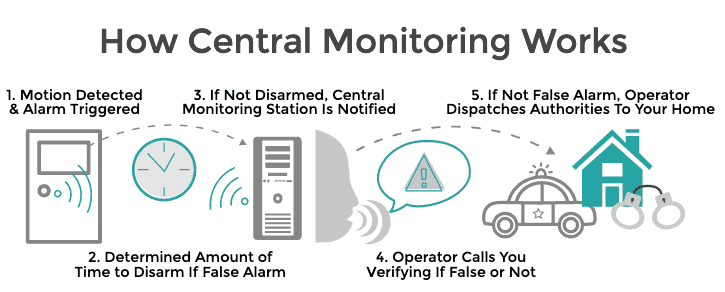
- The alarm triggers, and you have 30 seconds (or other designated amount of time) to disarm the system in case it is a false alarm. (This allotted time reduces the risk of being charged a fee for a false alarm.)
- If you don’t disarm the system, it notifies the monitoring station.
- The first available operator gets your information and instructions for what to do when an alarm event occurs.
- The operator follows the instructions (typically calling you to verify that it’s not a false alarm.)
- If it’s a real alarm, the operator dispatches authorities to your home for investigation.
In these 5 steps, the monitoring company’s response time equates to the elapsed time between steps 2 and 3 (the time between when the monitoring station receives the alarm event and it is assigned to an operator). The response time does not include the time designated for disarming an accidental alarm in step 1.
The shorter the response time, the better. A monitoring station may have a slower response time if it lacks employees, has outdated software, poor training practices or lack of proper redundancy.
Landline vs Broadband vs Cellular Monitoring
The central monitoring station receives your alarm’s distress signal one of three ways: via a landline, broadband or cellular connection.
| Landline | Broadband (Internet) | Cellular | |
|---|---|---|---|
| Typically The Least Expensive | |||
| Good For Those In Remote Locations | |||
| Works During Power Outage | |||
| Works With Home Automation | |||
| Widely Offered By Companies | |||
| Faster Connection To Monitoring Station Than Landline | |||
| Not Easily Defeated By Burglars With Wire Cutters | |||
| Most Reliable |
Landline Monitoring
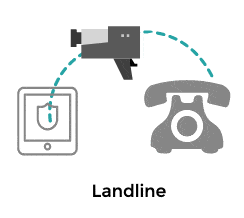 Landline monitoring is typically the least expensive form of monitoring, but burglars can easily defeat them with a pair of wire cutters. Also, fewer homes have landline phones than in the past, so this type of monitoring is quickly becoming obsolete.
Landline monitoring is typically the least expensive form of monitoring, but burglars can easily defeat them with a pair of wire cutters. Also, fewer homes have landline phones than in the past, so this type of monitoring is quickly becoming obsolete.
However, if you don’t have high-speed internet or you live somewhere with an unreliable cell signal, you may opt for landline monitoring.
Additionally, if you want home automation, landline monitoring will not work. Very few companies still offer landline monitoring.
Broadband Monitoring
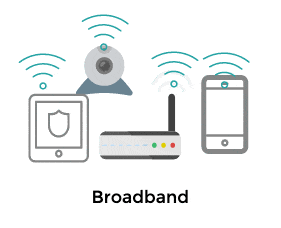 Broadband monitoring is a step up from landline. It provides a faster connection to the central monitoring station. You must have home internet with a specific bandwidth to use broadband monitoring (requirements vary by security company). Unfortunately, broadband connections won’t work during a power outage. And a burglar could cut your power and obtain access to your home.
Broadband monitoring is a step up from landline. It provides a faster connection to the central monitoring station. You must have home internet with a specific bandwidth to use broadband monitoring (requirements vary by security company). Unfortunately, broadband connections won’t work during a power outage. And a burglar could cut your power and obtain access to your home.
If you have an older home with plaster walls, you probably won’t want a broadband security system. Most plaster walls have a metallic mesh framework, which can interfere with WiFi signals. Broadband is what most companies offer in their starting packages.
Cellular Monitoring
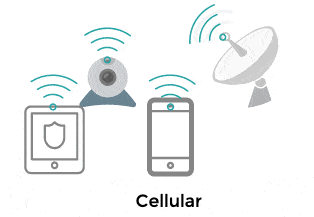 Cellular is generally the most reliable because there is no power outage or wire cutting risk. For that reason, it’s also the most popular.
Cellular is generally the most reliable because there is no power outage or wire cutting risk. For that reason, it’s also the most popular.
However, a crafty and well-financed burglar could obtain a jammer. This is a transmitter used to prevent signals from reaching the security system’s control panel. Jammers can be difficult to obtain because they’re expensive and illegal. But since when do criminals follow the law?
Of these three, we consider cellular to be the best monitoring option because it is the most reliable and secure. After all, wire cutters are available at any hardware store, whereas jammers take more effort and money to obtain. Cellular is typically the most expensive form of monitoring for this reason.
Self vs Professional Monitoring
Professionally monitored security systems are safer than self-monitored security systems, however, they each come with their own pros and cons. Below are the pros and cons for a typical self monitored and professionally monitored security system. Please know that some items can vary depending on the system.
Self Monitoring Pros |
Self Monitoring Cons |
|
|
Professional Monitoring Pros |
Professional Monitoring Cons |
|
|
Monitoring Comparison
Now that you’re familiar with the three primary types of monitoring technology, here’s what the companies we review offer. “Backup” indicates that that form of monitoring is available as a fallback option only if the primary form of monitoring fails. Click on a company name to be taken to that company’s review.
| Security Company | Landline | Broadband | Cellular |
|---|---|---|---|
| Abode | Backup | ||
| ADT | |||
| AT&T Digital Life | |||
| Brinks | Backup | ||
| Frontpoint | Backup | ||
| Link Interactive | |||
| Nest Secure | Backup | ||
| Protect America | |||
| Protection One | |||
| Ring Alarm | Backup | ||
| Scout Alarm | Backup | ||
| SimpliSafe | Backup | ||
| Vivint | Backup |
Why Do Monitoring Stations Matter?
Before you sign a contract with a security company or purchase equipment, you should know which monitoring company they use. After all, you will rely on the monitoring station during the potentially scariest times in your life. Not only do you want a fast callback from the monitoring station, you’ll want to be familiar with your law enforcement precinct’s response times.
Our experts have put together a guide on the average police response times across the U.S., categorized by incident priorities.
The quantity and quality of monitoring station is examined closely by our expert researchers to help them determine which home security companies are best. We gave your our top picks at the top, but we’ve reviewed over a dozen popular companies in case you’re interested in or have heard about a particular provider in our annual home security systems reviews.
Are you leaning towards a security system with professional monitoring?

